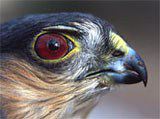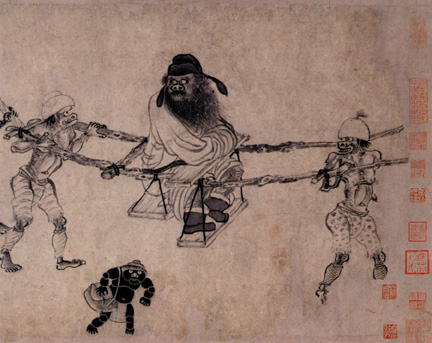
As most readers know, when we practice baguazhang we walk a circle, sometimes around a tree or a pole. If one is practicing different ways of changing direction on the circle, as opposed to a form or routine, we call this "
practicing the changes" or practicing "palm changes."
There are many different ways of organizing information into categories so that it can be remembered by students. By putting teachings into categories it makes them easier to remember (especially for the illiterate, or when what you are practicing might be illegal). Thus in some schools of Baguazhang all the teachings are divided into 8 categories. Each of the 8 categories has one
Mother Palm and an assortment of teachings and variations, sometimes called
qi transmissions.The teaching about the eyes for the
first Palm Change
(Chien) is one I have described in earlier posts. It is to look into the distance with relaxed eyes. If you do this with your hand up while walking around a pole, you will see two illusions. One, the hand will appear double, and two, the pole will look like it is turning on its own.
The teaching about the eyes for the
second Palm Change
(kun) is that the eyes relax and draw in. Like I described predictor eyes in a
previous post. If you use this type of gaze to move toward someone it feels like they are getting closer to you, as if you were drawing them

in. This is a subtle but important distinction. Usually when we walk toward someone we have a sense of our body getting closer to them, predator eyes are intrusive.
In the
third Palm Change
(xun), we practice spinning. While we are spinning we relax the eyes so that they don't catch or focus on any one thing, even at the moment when we stop spinning, or change direction. This means we are practicing becoming comfortable with the whirl or blur of the world passing by. The moment one locks on to something with their eyes, they have to keep repeating that, or they will get dizzy.
(Dancers and acrobats generally use a different technique something called "spotting,"

which means they focus intently on a point and then whip around to see that point again. One can also whip around from a point to another pre-chosen point. In North Indian Classical Dance we would "spot" on all four walls, spinning one and a quarter turn between each split-second turn. This cool effect was sometimes used to create the illution of a multi-armed, multi-headed deity.")
Normally our eyes are changing all the time. It's easy to imagine meeting someone whose eyes are continuously suspended in one of these patterns. If you saw someone gazing far off into the distance as they were getting on a bus, you'd wonder if they were seeing paradise just a bomb blast away. This is a
yang use of the eyes, and is associated with, among other things, heroic martyrs.
I described the
yin eyes of the
second palm change in the
brutalized assassin I mentioned in an
earlier post on eyes.
Everyone is familiar with the eyes of the third palm change, it's what happens when we drink too much alcohol. Drinking alcohol and spinning, or dancing in a circle, until one falls down is a
staple method of shamanic practice used to contact
spirits in many parts of the world.
Previous posts on
Eyes and
More Eyes In the martial arts world I've encountered three basic types of teachers, all of which are great and all of which have draw backs.
In the martial arts world I've encountered three basic types of teachers, all of which are great and all of which have draw backs. both in innovation and in the history of how each aspect of the art developed.
both in innovation and in the history of how each aspect of the art developed.
 toward them. I know of an old Gongfu master who worked bank security and kept a bit of metal-filings dust in his pocket to throw in peoples eyes if necessary. Better hope your blink reflex is operating if that happens. Taken to a possessed extreme, these are the bug eyes we sometimes see on crazy people.
toward them. I know of an old Gongfu master who worked bank security and kept a bit of metal-filings dust in his pocket to throw in peoples eyes if necessary. Better hope your blink reflex is operating if that happens. Taken to a possessed extreme, these are the bug eyes we sometimes see on crazy people. As most readers know, when we practice baguazhang we walk a circle, sometimes around a tree or a pole. If one is practicing different ways of changing direction on the circle, as opposed to a form or routine, we call this "practicing the changes" or practicing "palm changes."
As most readers know, when we practice baguazhang we walk a circle, sometimes around a tree or a pole. If one is practicing different ways of changing direction on the circle, as opposed to a form or routine, we call this "practicing the changes" or practicing "palm changes." in. This is a subtle but important distinction. Usually when we walk toward someone we have a sense of our body getting closer to them, predator eyes are intrusive.
in. This is a subtle but important distinction. Usually when we walk toward someone we have a sense of our body getting closer to them, predator eyes are intrusive. which means they focus intently on a point and then whip around to see that point again. One can also whip around from a point to another pre-chosen point. In North Indian Classical Dance we would "spot" on all four walls, spinning one and a quarter turn between each split-second turn. This cool effect was sometimes used to create the illution of a multi-armed, multi-headed deity.")
which means they focus intently on a point and then whip around to see that point again. One can also whip around from a point to another pre-chosen point. In North Indian Classical Dance we would "spot" on all four walls, spinning one and a quarter turn between each split-second turn. This cool effect was sometimes used to create the illution of a multi-armed, multi-headed deity.") There was a debate with in the Zen community a few years back about whether the eyes should be open or closed. In the Orthodox Daoist practice of jindan, the eyes change between being closed, open and half open. Some scholars have suggested that a method mentioned in the Zhuangzi called "fixed staring," is actually a form of meditation. In my opinion it could only be a form of trance, there is nothing "fixed" about the eyes or the focus in the practice of meditation.
There was a debate with in the Zen community a few years back about whether the eyes should be open or closed. In the Orthodox Daoist practice of jindan, the eyes change between being closed, open and half open. Some scholars have suggested that a method mentioned in the Zhuangzi called "fixed staring," is actually a form of meditation. In my opinion it could only be a form of trance, there is nothing "fixed" about the eyes or the focus in the practice of meditation.
 I went to two parties after teaching all morning yesterday, so I haven't had time to edit all the comments in moderation. Sorry I'll get to it soon.
I went to two parties after teaching all morning yesterday, so I haven't had time to edit all the comments in moderation. Sorry I'll get to it soon. When you move forward, you should have the feeling that objects- people, rocks, trees- are being drawn-in toward you, not that you are getting closer to them." (I'm paraphrasing here.)
When you move forward, you should have the feeling that objects- people, rocks, trees- are being drawn-in toward you, not that you are getting closer to them." (I'm paraphrasing here.) thought it was pretty funny and in good taste.
thought it was pretty funny and in good taste. Sinking one's center of gravity.
Sinking one's center of gravity.
 The third century B.C.E. text known as the
The third century B.C.E. text known as the 
